
|
||
|
Portland art blog + news + exhibition reviews + galleries + contemporary northwest art
|
||
First First Thursday Photoblog part 3 Continuing across Burnside into SW, I walked along second street to Augen Gallery. It was approaching 9 and things seemed to be winding down. I arrived at Augen and Froelick just as everything was being put away. Augen gallery has a show in the back of Marcel Dzama! I was excited to see it, but they had already lowered the lights in the next room, so instead I looked at Susan Larsen and Patrick Collentine's "Kolorbar, Present Perfect". These are landscape photographs in which a figure holds a seven foot color bar test pattern in front of their body at the same distance in every frame. The test pattern gives a true CMY RGB color reference for each photograph, which I imagine they work from when developing the pictures. The point seems to be that the photograph on display is as true to the real color of the landscape as can possibly be humanly acheived. The name of the show suggests that the photographers are trying to perfect the present, and see the tools of photography as a means to that end. This seems like a laughably futile idea, like the king in "The Little Prince" who commands the sun to rise every morning, and there is something funny about these grand landscapes with someone holding a test pattern over their head in the middle of them. And how does creating a photograph of something perfect it? Perhaps the title refers to perfecting the photograph. A perfect photograph can be thought of as a perfect record of the present.
Stephen Hawking would argue that a photograph is only a good representation of time when you use Euclidean Space-Time, in which time is one-dimensional, a line, and lines are of course constructed of a series of points. Each point could be represented by a single photograph. The perfect model for the Euclidean concept of time is of course the film, a series of still photographs. But in the Einsteinian model, which we now accept as the truth, time is simply one function of larger, inter-related phenomena. In Einstein, space, motion, gravity, mass, energy, and time are all interchangeable, all relative. So Stephen Hawking constructs a model of time as a "light cone" a set of possibilites which can be redirected as any of these factors change. and here are the Marcel Dzama lithographs I did not see. All untitled, from the "Cabin of Count Dracula Suite" 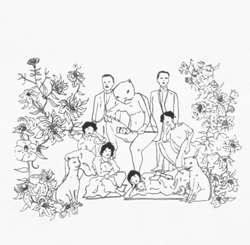
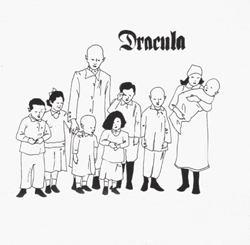
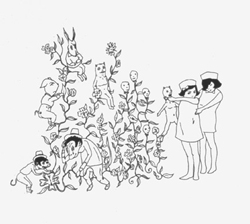
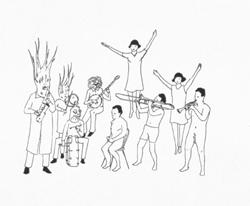
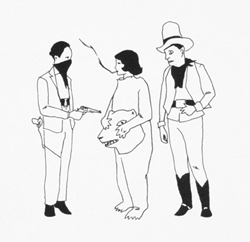
Here are some selections from Froelick Gallery's (next door) Winter group show: Laura Ross-Paul 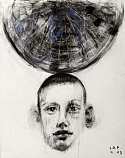
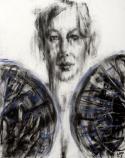
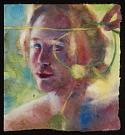
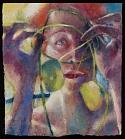
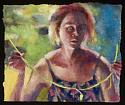
Barry Pelzner 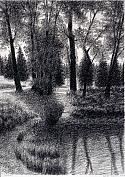
Matthew Dennison "Volplane Walther" Gail Tremblay "As Long as the Grass Grows" Susan Hornbeak-Ortiz "Truth" Walking back along Second Ave., towards Sugar gallery, I saw this "art car" parked at Kinko's and photographed it in the interest of diaristic veracity. Don't be afraid, I am not becoming seduced by "burning man" aesthetics, although I've rented "Mad Max beyond Thunderdome" this weekend in order to develop some ideas about it. However, I must admit to being interested in Sea Serpents. I really like the fact that they can be represented by a simple, evenly spaced series of arcs with a monster head at one end and a tail at the other. I also like that the arcs imply a converse series of imaginary arcs, in this case occurring inside the car itself. In addition, the idea of the sea serpent has some appeal to every amateur Cetologist because the sea serpent myth, of course, describes whales. I unfortuantely missed the opening at Chambers gallery, but I did snap a couple of pictures of Wid Chambers' digital paintings made with archaic imaging programs through the front window. So, on to my final destination, Sugar Gallery's first show, in the old Gallery 500 space. This was Corey Smith's ultra-slick "Seven Day Weekend" So, if I'm to be honest, I have spent some time myself trifiling with the idea of "cool" and playing with the illusion, however transparent, that I'm something other than an ultra-fragile reclusive art nerd. I recently purchased some black converses with red flames on them, and sometimes when I look down at my feet I think to myself, "wow, I am cool." And then there is my habit of bringing David Bowie albums with me to the barber. I think to myself, "If my hair looks just like David Bowie's hair, I will then become cool." But ultimately, I realize those who are truly cool don't need to constantly re-engineer their coolness. It is simply a state of being, an ontological mystery. In viewing Corey Smith's art, I realized that the word "cool" is actually not so much slang as descriptive term. The work is cold, passionless, desensitized. A cynical response to the hollowness and soullessness of popular culture in which the artist feels inundated. Corey describes his style in his artist's statement as: "Post-Hope Pop," and in this world-view Paris Hilton steps in as the Angel of Death. Paris is the one celebrity observant and honest enough to recognize and admit to the fact that commodity is an ontological state. While Brad Pitt guards his privacy with recalcitrance, pleading in interviews to be considered as a complex person rather than a sex symbol, Paris states the simple truth: "I am a product, and I wish to be more marketable to the public." Smith's work satirizes the hollowness of commercial culture using the traditional tools of Rock 'n Roll desensitization: Sex, Drugs, Weapons, Cigarettes, General ridicule of nostalgic wholesomeness. In the artist statement he identifies his own cynicism as well as apologizing for it, something along the lines of: "I don't consider myself cynical, but culture seems to constantly reinforce my cynicism." That's when I begin to see "cool" and "critique of cool" or "anti-cool" as thesis and antithesis in what is, in fact, a complete Hegelian dialectic. "Anti-cool" is "cool". You can't critique "cool" because the definition of "cool" is "that which does not respond to critique." Therefore, "anti-cool" is simply a development of a new branch of "cool" itself. Rather than address the hollowness of culture, Smith's work instead develops its own hollowness. It is not, in fact, a true response to what it claims to criticize, it is actually participation. Smith's thesis statement is an obvious one, easily observed as the truth. Commercial and celebrity cultures are spiritually dead and offer virtually nothing of value to the ontological development of the individual. Smith sees commercial culture as an inescapeable juggernaut to which the individual must submit themselves for assimilation. But while becoming assimilated, the conscious individual can analyze and satirize the process of desensitization they are undergoing through decadent experience. As in: "I am so numb, I can smoke a hundred cigarettes at once and not feel stimulated." "I am so numb, sex has become a mechanism, and I can no longer differentiate between my waking life and the experience of altered consciousness due to drug use." "I am so numb, even violence can't elicit a reaction." So, I am going to write a Bene Gesserit litany against cynicism. Commercial culture is hollow and spiritually dead. It has nothing to offer to the ontological development of the individual, but where does culture originate? It is not manufactured by a corporation, it is created by the individual in cooperation with other individuals. To give in to cynicism and the assimilation of desensitization is cowardly and irresponsible. The biggest ontological fear experienced is not that life is hollow and meaningless, but that the individual is powerful and that life is meaningful. Because culture originates in the individual, whatever companies manufacture as cultural currency or image currency is irrelevant. The individual can select or discard whatever they please in the construction of culture. Also the possibility exists for the individual to create new cultural signifiers that do not yet exist in the world. This practice is called Art, and is, in its very essence, optimistic, no matter how urbane or esoteric it might seem to become. No matter what else it might be, Art is a process of re-sensitization. After all, wasn't decadence just one more thing commercial culture stole from (and sold back to) the individual in its campaign towards desensitization and commodity? Sex, Drugs and Rock n' Roll were not always associated with the numbing effects that they produce today. It took a long time to discover those ideals could become marketable products. In the 60s those same ideals were cathartic and sensual, and the life of Arthur Rimbaud in the late 19th century was more decadent than any rock stars', and not a moment of it was numb. As I watch people at the gallery opening not dancing, but making fun of dancing by pretending to dance, I think of a 16 year old Rimbaud drunk on absinthe, lying in a ditch in the winter, watching the stars blaze and whirl overhead, lucid through the absinthe haze, composing perfect hexameters in Latin which he whispers under his breath. It is recovered. What? Eternity. In the whirling light Of the sun in the sea. O my eternal soul, Hold fast to desire In spite of the night And the day on fire. You must set yourself free From the striving of Man And the applause of the World! You must fly as you can... No hope, forever; No orietur. Science and patience, The torment is sure. The fire within you, Soft silken embers, Is our whole duty- But no one remembers. It is recovered What? Eternity. In the whirling light Of the sun in the sea. Posted by Isaac Peterson on January 08, 2006 at 8:15 | Comments (19) Comments The image of the kid with a pile of cigarettes in his mouth is pretty funny. Kind of like the Rolling Stones record cover with the guy with a bunch of balls in his mouth. Posted by: jerseyjoe Did I miss something? Where does Corey Smith imply that he is anti-cool and therefore cool? Your ruminations on footwear aside, Smith's work can be read as documentation of an age when "coolness" became extinct. Nowadays, cool is used as a pejorative. People use "hipster" the way Dick Cheney uses "liberal". Judging by the number of artists working in a similar vein as Smith, the inability to rebel/differentiate oneself in time-honored fashion is very much on the minds of young people. I don't blame them. The instant commodifcation of anything remotely original is a relatively new phenomenon, and presents a sea change of difference from the youth cultural experience of decades past. On another note, Cynicism isn't the antithesis of optimism. A cynic is doubtful of human nature or of the motives, goodness or sincerity of others. Cynics usually have, and work towards ideals. If they don't, they become pessimists. The opposite of cynicism is gullibility, or the tendency to trust and believe people to the point of being easily tricked or deceived. I think we already have enough of that in the world. Exactly when did this ridiculous mandate for optimism begin? The most casual glance at art history shows powerful movements and individual works that have nothing at all to do with optimism. Much of what passes today as optimism in art comes across as snide marketing akin to President Bush standing at a press conference in front of one of those backdrops that read something like Things Are Going Really Great Now. Smith may be a cynic, but I don't see him as a pessimist. If he were, he wouldn't bother picking up a brush. Like a lot (a lot) of other artists, he's trying to get some traction on slippery, well-trod ground. It is no less slippery than the equally prevalent "take some dope and paint an alternative reality" approach to art. Again, the results are what count. Smith has every right to be cynical...if he does come across the perfect new "signifier" for our culture, he can be sure that Weiden + Kennedy will put it in an ad the very next day (something Rimbaud, hippies and punks didn't have to worry about). Posted by: stephencleary Actually hippies and punks very much had to deal with the instant commodification of anything novel... and termed the instances as sell-outs accordingly. But yes it has gotten worse... or better.... or maybe everyone has a shorter attention span. Also, I think Ike is really discussing the apparent intent of the artist and wrangling with the nagging doubt that this is just a snide affectation and a cynical negation as a mode rather than an a life (and life's work) thoughtfully explored. Maybe the real discussion is one of critical thinking vs. affected ennui. Posted by: Double J yeah, you know, I think I'm playing devil's advocate a little bit with corey, because, as one of my friends pointed out, one thing his work really does clearly and graphically communicate... It is a pretty potent show really.... Corey works in a way that has a lot in common with sign painting.. I guess my biggest complaint is in reading his statement and then looking at the work... it is a very unsatisfying relationship... He talks about the emptiness of commercial culture and how his paintings reflect said emptiness Of course I think those are accurate observations, but the paintings are presented in a way that is inseperable from the mechanism of commercial culture itself. The paintings are products and don't actually examine commericial culture in a complex way, they simply activate it. Each painting is like a marketable product, a single succinct statement, a closed loop, a one-liner... i.e. "perfect american home" = image of something ridiculing statement.... It reminds me of the aesthetic strategy behind those beer posters in dorm rooms... You know, like the poster has a sentiment best expressed by a frat boy, but the speaker is actually a trusted 50's dad... the image conflicts with the text and therefore the humor seems especially seditious or incisive... but it's an engineered tension, both the 50's dad and the frat boy are fictive consciousnesses outside of real experience... I would like to see something as cynical, as "post hope pop", as funny, dealing with the same subject, using the same techniques, without the engineered tension: with real, complex sedition and incision.... both psychologically and culturally... a real response to the vacuity of commercial culture... With corey's virtuosic line work and refined graphic method, it could be so much more than a one joke rim-shot... Corey's basically a sign painter right? I mean, think of Rosenquist! He painted billboards, dealt primarily with themes derived from products and cynical visions of culture and politics in networks of associations (nuclear bomb = airplane = spaghetti = lady at the salon) but in a way that was complex. A Rosenquist painting isn't an easily gift-wrapped succinct product, it is a vast sprawling lattice of associations, and reflects not only the psychological effects of commercial culture (cynicism) but the disruptive effect that image bombardment has on the psyche in total! I would just like to see something that didn't tie up so neatly... I guess his mode is a little boring to me, usually an image + a joke, where the image illustrates the joke, or adds unexpected complications to the meaning of the phrase... But the thing about commercial culture, is that the associations it is able to make are absolutely crazy! In a commercial you can associate any image with any phrase in a way that makes no sense at all, slap in the through line of the product, and the viewer somehow accepts continuity in a ludicrous phantasmagoria of images... That's kind of what Rosenquist shows in his work... he just takes out the continuity and leaves the viewer to assemble the images... which is actually suprisingly quite easy, because we all have learned the lexicon of hyperstimulation through images... The other day I was out running and I saw a bilboard for coca-cola which had a polar bear and a penguin sitting together on an ice field watching a gigantic moon rise and sharing a coke in the "old green glass bottle". (you know, the kind they don't make anymore... I guess they stopped manufacturing those as soon as word was out that America had lost its innocence) I was suddenly struck by a huge sense of discontinuity, and I couldn't figure it out for the life of me... there was something I just couldn't accept about the image, and it wasn't that the bear was able to hold the bottle, or that the moon was so gigantic, or the weird individuation of the CG fur... Finally it struck me, Polar bears live only in the arctic and penguins live only in the antarctic! Was this part of the phenomenon of the product? Was it part of the campaign? The power of freindship coca-cola can create can bridge the gap between the poles, even if the whole earth seperates the two... And then I realized... no, not at all, it was simply nonsense... Coca-cola assumes that in the american mind all snowy places are one place... And the fact is, that's the truth... commercial culture breaks down psychological differentiation to the point where we are able to think of dish soap as having something to do with sex... to the point where our ability to differentiate becomes insubstantial or outmoded... Then I started to think what an ideal meal a penguin would be for an apex predator like a polar bear... with a nice cold coke to wash it down... I think Corey should stop tying things up so nicely... I mean, the images are just so gratifying... you look at the painting and it tells you a joke, and it illustrates that joke.. There's no reason to pander to an art audience the same way commerce panders... let some of it breathe.. let some of it have some holes and unanswered questions... let some of it use the language of pop destructively rather than instructively... Can you imagine a post-hope Rosenquist? That would be mind-blowing! I don't mean to say that Corey should emulate Rosenquist, or give up cynicism, (actually Rimbaud is pretty cynical too) but he should seek to expand... he should look for the difficult painting that will emerge out of all of the easy, tidy ones... he should stop making the simple jokes that will entertain people at his openings and make the greater work, and when it comes, I think it will be far more difficult to understand.... it will be more complicated, funnier, and more cynical, as well as a better insight into the culture... All of his tools are already in full form... and I think the imagery is there too... It's just the meaning... the meaning and the recklessness... will he dare to step outside of the bounds? I mean the real bounds? to make a painting that isn't so neat and tidy? Something that you can't read fully with a single glance, smirk and move on? Posted by: Isaac The call of "sell out" in the punk and hippy scenes is laughable by todays standards. There was no instant commodification in either movement...information moved at a much slower pace, and the scenes were comparatively microscopic in size. The subculture had time to become established and there was room to maneuver. There is no dominant underground scene now...just a bunch of people making things and a bunch of people searching for things. I also think Smith has a lot of room for improvement. The commercial culture stuff does nothing for me. What seems to interest people is the youth ritual work.(and like i said, this is also a busy field). But noone has really hit a homerun in this area. I think Speer went gaga over the coke snorting stuff last year. Smith needs to refine his cynicism, rather than abandon it. Posted by: stephencleary Well, Ill argue that there was a lot of commodification of the hippie thing and it was pretty instantanious (case in point the quasi band The Monkees). Was it as widepread and horizontally implemented as it would be now? of course not. As long as we have had capitalism we have had instant commodification. It's just ridiculously efficient now and it is why we have trend spotters roaming Portland on a very regular basis. Back in the 60's the corporate marketing types still looked at subcultures and figured out how to market cigarettes, clothing, food, booze, music and films to the mods, hippies etc...
Posted by: Double J Weren't the Monkees more of a commodification/crass Americanization of the Beatles than of hippie culture at large? Yes, I think so. Perhaps the Partridge Family better represents commodification of hippie culture... well, not really. They dressed kind of hippie-like and drove that great Mondrian-inspired van, but weren't really hippies, were they? That said, where does it leave the Banana Splits? Have we even begun the commodification of psychedelic/theme park character culture? Oh, the horrors. I'll let Isaac or Jeff tackle Josie and the Pussycats. Posted by: MB In the past, the commodification was slow to come and so wrong it was no threat. Is anyone old enough to remember the ChiP's or Quincy "punk" episodes? In the ChiP's episode, Ponch learns that New Wave is optimistic and punk is not. Ponch ends up winning the battle of the bands with his version of Celebration. Modern marketing practices are more likely to be dead on. Posted by: stephencleary I agree with Mr. Cleary. Things did not happen so fast. Iggy will tell you that the reason he allowed Lust For Life to become a commercial is because he made zilch when it was released. "Everyone" was not listening to it at all. It became commercialized.... what, 20 years later? Posted by: lsd Well of course the Monkees were the fake Beetles... sort of. They were simulacra that were good enough to have some #1 songs and they had widespread market penetration. (I like this discussion) It's true though, a marketed doppleganger of the "real deal" can now be capitalized upon so fast it ends up becoming what everyone remembers. It's part of the reason I really like Murakami, he beat the marketers at their own game. Otaku King indeed! Corey Smith has a long way to go before he is there. #2) Yes MB I watched every episode of Chips... but my favorite had to be "Automan" or "Manimal". Comedy, be it the 60's or the 21st century has always been very adept at putting a spotlight on what is interesting at the moment. Im not certain Art is supposed to do that. Instead it is more reflexsive and meta, like Rauschenberg's Combines and Donald Judd's boxes. Even Kandinky wasn't originating any new ideas... he merely took some theosphistical society mutterings about synthaesia and made some paintings. The question with Smith's work is... is it just entertaining comedy? so far I havn't seen enough of the reflexive element to convince me further and I share Ike's skepticism. Posted by: Double J Hilarious that we're giving Smith so much credit. Are we going to follow this up with a philosophical discussion about skateboard graphics, trucker's hats, novelty t-shirts from Spencer's, and Jim Riswold's photographs? Posted by: jerseyjoe At the very least I hope Smith makes some new work and takes this to heart. I think some day Port will do an "ultimate hipster/ art scene poser" blog post. Until then we can continue to crucify Smith as some kind of hipster messiah. The Who could even record a pretentious concept album about him... then Nathan Lane and Matthew Broderick could star in a Broadway adaptation of it. I think it would practically write itself! fah... Posted by: Double J Wow, you guys are really smart. Thanks for the review, You guys gave me some great material to juice up my artist statement for next time. I'm glad my show got you talking...The fact that anyone is even debating my work is a huge compliment. Isaac, thanks for the Rimbaud poem, that was, well, really weird... Listen, I'm not trying to change anything or tell anyone how things should be. Post Hope is realizing that things are fucked up and there is little that can be done. Basically we're all rats on a sinking ship. There is no truth anymore, only slick marketing and opinion. Every ideal that's ever been held in regard has been shattered. Love, marriage, the American Dream, family, truth, hope, naivety, art, everything. I'm just trying to sift through the detritus just like everyone else trying to figure it out. Here's my take on our current situation and what keeps me awake at night. (which may seem obvious to everyone) Living in a Christian country, run by a Christian leader, one of the fundamental beliefs of contemporary Christianity is that the Apocalypse is eminent and that we are living in so-called End Times. You can't be a Christian and not believe that the Messiah is coming in our lifetimes, and the end of the world is near. The leader of the free world absolutely believes this. I think these are scarier times than any Cold War missile crisis. Whether you believe this or not the fact that these people in power are crazy enough to believe this is enough to make me raise my hands up and say I don't give a fuck anymore. I think there's liberation in giving up and realizing we're all just waiting it out.
So anyway, my paintings are more observations of the times. I try to add some humor when I can, otherwise it would just be a fucking drag. I want my paintings to be clear and simple and easy to get, whether you're "art informed" or some kid off the street. I don't understand artwork that has this so-called 'psychological deep emotional meaning lying beneath the surface" or whatever. I think those people paint things that look like they're on drugs. I think it's kinda fruity and pretentious, like because you're an artist you feel something deeper than a regular person (I think that's bullshit). On another note: I don't know what "cool" is. I'd like to think my art is pretty "cool". I think it would be really "cool" if someone bought a painting so I wouldn't be broke.
Please come to my closing party on Sat. night at the Sugar. it'll be a good time. thanks again for looking at my work. Posted by: corey smith Glad to see Corey got to see this great review of his work. I am a huge fan of Corey's work, simply because it really does have that feeling of "cut the bullshit," this is how our lives really look. I once overheard someone attempting to describe his work as lacking meaning and trite. I can only wonder what world this person is living in, because it sure as hell isn't ours. Just because there is a little bit of humor in Corey's work doesn't mean that depictions of a boy snorting cocaine or other "hopeless" images mean there is a lack of sincerity in the creation of his art. So anyway, kudos to you Corey, and I'll try to make the closing party. I'm sure it will be a good time. Posted by: Calvin Carl I believe we are in a time of cultural transition. And in such a time, a void is a very resonant image for us. We feel disconnected from both past and future. Our old mythologies are no longer potent and there are no new ones propelling us along. Paris Hilton is the manifestation of void. There is nothing wrong with a void. It is neither good nor evil. It is simply a lack of substance. So what is a portrait of a void? It is also void. Staring at the void will get you nowhere. But maybe it is time to stay still. Paris Hilton gives us pause. That's all. Maybe we need that in our fast-paced world. Maybe we need a symbol that doesn't make us stop and think, but simply makes us stop. So here we are, stuch on the pause button, or with the needle skipping on the record player. Personally, I'm sick of staring at Paris and I'm ready to move on. The void is a sign that something new is on the way Are we going to stand there looking at the finger or are we going to ask where it is pointing to? Posted by: emjane The finger is pointing nowhere, there's nothing to point at, that's the point! Pop art is regarded as love, acceptance of everything, optimism, generosity, naivety, and the American Dream. I consider my work to be post-hope Pop art, the anti-thesis of the unrealistic ideals found in every aspect of modern society. Post-hope is the realization of an empty existence, and the acceptance that itís all a big sham, and loving it. Post-hope is the breakdown and betrayal of everything thought to be just and righteous. Iím not becoming more cynical I just find more and more evidence to support my cynicism. enjoy life, Corey Smith Posted by: corey smith Best line ever... It's funny. Corey's critics say there is nothing there in his art. It is just cool and hip, and has no lasting value beyond that. Yet, here we are, out of all the amazing artwork in the world, talking about this "sub-par" art. Congrats Corey, you are doing something right. Posted by: Calvin Carl I like the painting of the kid with the mouthful of cigarettes. I wouldn't mind having a print of that one. Does Smith make prints of his work? Posted by: jerseyjoe How is reproducing constantly reproduced images of starlets like Paris Hilton the "anti-thesis of the unrealistic ideals found in every aspect of modern society". I thought she WAS the unrealistic ideal. And as for Jersey Joe's comment that a cynic is working toward ideals, will someone please explain to me how reproducing the infinitely reproduced works toward an ideal? I mean, I'm serious, maybe there's something I don't understand here. I guess my question is why aren't you "trying to change things or tell people how things should be"? You don't seem too content with them. Oh, I guess it's that whole "Post-Hope" thing. Well, I'm sorry your so sad, and if looking at Paris Hilton makes you happy, go for it. If thats really all you've got, embrace that. Just don't assume that we all have to live in that world with you. It's called turning off the TV. If it weren't for all these young art boys reproducing her image I'd never see her face at all. (Maybe occasionally at the check out stand, but not enlarged and glorified as if she were some kind of God). She is completely irrelevant to my life, and yet it seems that some artists want to keep shoving her in my face and insist that she is. I'm not buying it. Sorry. Posted by: emjane Post a comment Thanks for signing in, . Now you can comment. (sign out)
(If you haven't left a comment here before, you may need to be approved by
the site owner before your comment will appear. Until then, it won't appear
on the entry. Thanks for waiting.)
|
| s p o n s o r s |
 |
 |
 |
 |
 |
 |
 |
 |
 |
 |
 |
 |
 |
 |

|
Site Design: Jennifer Armbrust | • | Site Development: Philippe Blanc & Katherine Bovee | |


![[TypeKey Profile Page]](http://www.portlandart.net/nav-commenters.gif)